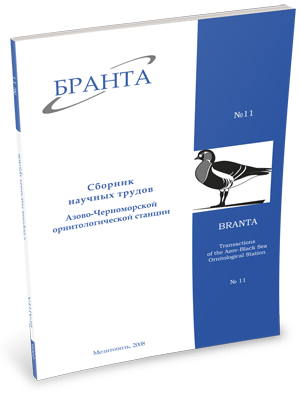
Transactions
of the Azov-Black Sea Ornithological Station



Present state of nesting-places of the Cormorant (Phalacrocorax carbo) in the wetland "Molochnyi Liman".
R.N. Chernichko
Attitude of people towards the Cormorant has been changed several times: from loyal terms (when numbers of the species were small) to conflict (when birds sharply increased in numbers).
Elaboration of scientific recommendations on control of the species numbers in current natural and socio-economic conditions should be based on knowledge about numbers, trends of their changes in various breeding groupings of the species and factors that determined these changes. Present paper analyzes the state of nesting-places of the Cormorant in the Molochnyi Liman that is the largest wetland on the Sea of Azov coast of the Ukraine.
Materials for this work were collected during long-term investigations of birds of the Molochnyi Liman, carried out by ornithologists of the Melitopol State Pedagogical University and the Azov-Black Sea Ornithological Station in 1987-2008.
Within the Molochnyi Liman area the Cormorant has nested for the first time on Kirillovskie Islands (Fig.), later its main nesting-places moved to Podkova and Dolgiy Islands, and since 2005 the birds returned to Kirillovskie Islands again (table). Founders of the settlements were mainly young birds (the birds at age one year and younger - 20-25%, at age from 2 to 3 years - about 50-55%, and adults - only 20-25%). A number of adaptations of the species that allowed it to develop new areas and compete with aboriginal species are analyzed.
Islands of the Molochnyi Liman were occupied by the Cormorants, which came from Kuban breeding grouping. Post-breeding movements of fledglings show that most young birds pass to their wintering areas in eastern direction, along the Azov-Black Sea coast via the Krasnodar Region (44%); insignificant part of birds migrate in autumn in the western direction (25%) via the Kherson Region (n=3), mouth of the Danube River (n=1) to Romania (n=5), Bulgaria (n=2), Greece (n=1), Yugoslavia (n=1). Most young birds during the early and middle autumn (till November) stay not far from the birthplaces (24%), some birds (7%) migrate firstly inland (to northern part of Zaporozhskaya, Dnepropetrovskaya, Cherkasskaya Regions) and later probably make their way in migratory directions. Few Cormorants stay within their breeding area over the soft winters (n=2) (Eioaeaa, 2000). During the winter period some Cormorants from the Molochnyi Liman were observed also at the Don River (n=1), in the Krasnodar Region (n=22), Georgia (n=1), Turkey (n=3), Israel (n=17).
It is proposed to exploit settlements of the Cormorant in the Molochnyi Liman as a testing area for experimental researches and elaboration of scientific propositions on a regulation of the species numbers.
Read the paper in a PDF file